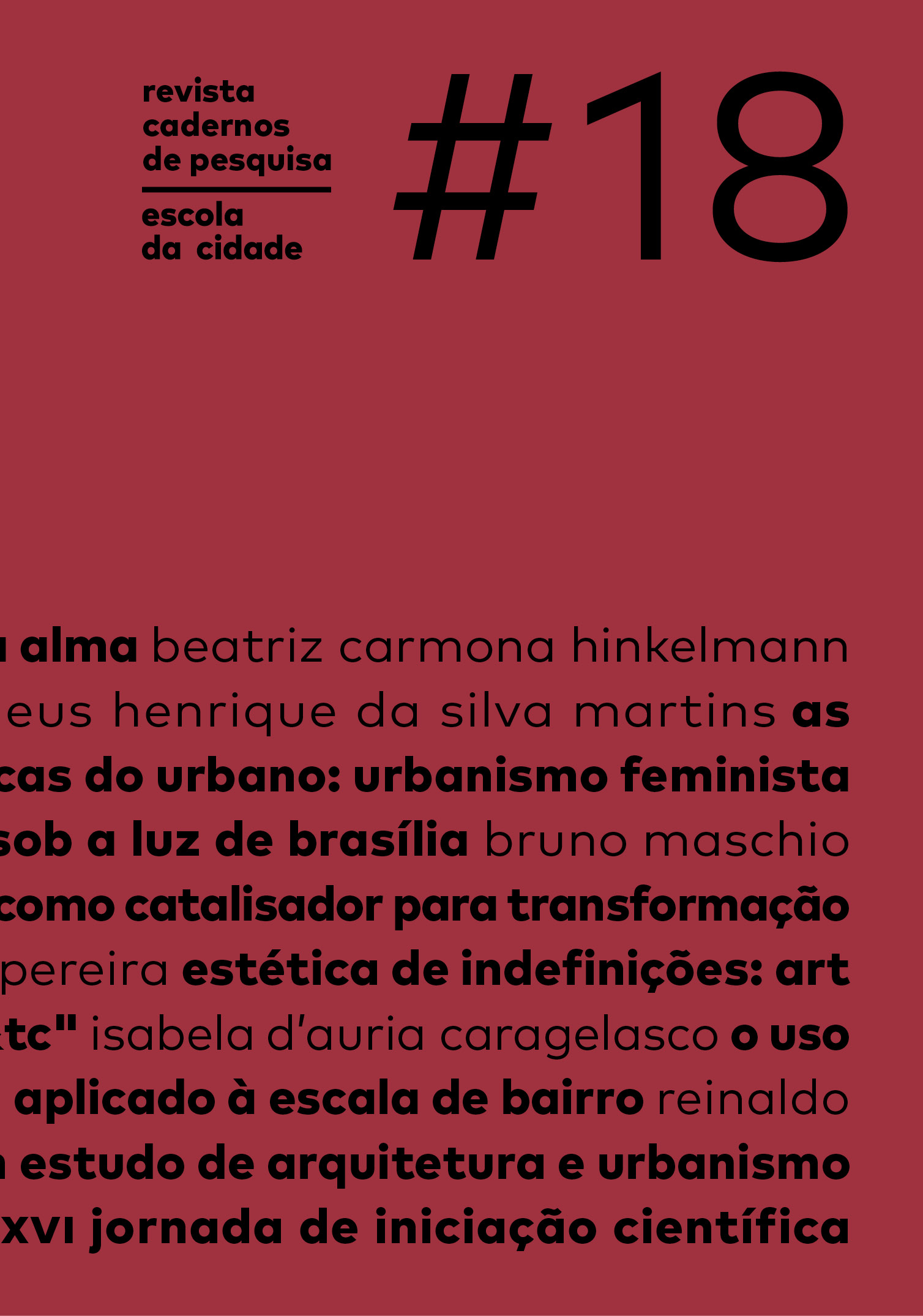Chan Chan, earth capital: A Study of Architecture and Urbanism from New Perspectives
Keywords:
Chan Chan, Indigenous America, Earth ArchitectureAbstract
This article seeks to address the history and historiography of Chan Chan, the capital of the Chimú Empire, founded in the 9th century in the northern coast of present-day Peru, and the largest city ever built entirely out of earth, with the purpose of disseminating and systematizing the existing body of knowledge about Chan Chan in order to encourage more nation-wide researches, which are practically nonexistent until now. The research, carried out with the support of a grant from Fapesp, being part of the initiatives of the Young Researcher Barroco-Açu Project (2021/06538-9) at the FAU-USP, aimed to outline the historical profile of the city, in parallel with a study of the authors and works that address the topic and advance researches. Thus, it seeks to highlight the importance of recognizing and valuing the cultural and architectural richness of Amerindian indigenous civilizations, as a fundamental learning tool in current times.
References
ANDREWS, Anthony. The U-Shaped Structures at Chan Chan, Peru. Journal of Field Archaeology, v.1, n.3/4, 1974, p.241-264. Disponível em: https://www.jstor.org/stable/529293. Acesso em: 25 ago. 2023.
ARCURI, Marcia. O Tahuantinsuyu e o Poder das Huacas nas Relações entre Centro x Periferia de Cusco. Revista do Museu de Antropologia e Etnologia, São Paulo, 2009, p.37-51. Disponível em: https://www.revistas.usp.br/revmaesupl/article/view/113507. Acesso em: 19 jul. 2023.
CHAN CHAN CELEBRA 25 AÑOS. La República, Peru, 28 nov. 2011. Sociedad. Disponível em: https://larepublica.pe/sociedad/593701-chan-chan-celebra-25-anos. Acesso em: 14 set. 2023.
CHAWELES, Felipe. Chan Chan, de Huaca a Huachaque: fontes para o estudo da antiga capital Chimú. Iniciação Científica. São Paulo: FAU-USP/Fapesp, 2023.
CONRAD, Geoffrey. Burial platforms and related structures on the north coast of Peru: some social and political implications. 1974. Tese (Doutorado em Antropologia) – Universidade de Harvard, Cambridge, 1974.
DAY, Kent; KEATINGE, Richard. Socio-economic organization of the Moche Valley, Peru, during the Chimu occupation of Chan Chan. Journal of Anthropological Research, New Mexico, v.29, n.4, 1973, p.275–295. Disponível em: http://www.jstor.org/stable/3629879. Acesso em: 23 set. 2023.
KOLATA, Alan. Chan Chan: the form of the city in time. 1978. Tese (Doutorado em Antropologia) – Universidade de Harvard, Cambridge, Massachusetts, 1978.
KOLATA, Alan. The urban concept of Chan Chan, 1985. In: The Northern Dynasties: Kingship and Statecraft in Chimor: A Symposium at Dumbarton Oaks, University of Chicago, Chicago, 1990, p.107-144. Disponível em: https://d3qi0qp55mx5f5.cloudfront.net/anthrolpology/images/faculty/zTheUrbanConceptOfChanChan.pdf?mtime=1447082262. Acesso em: 21 set. 2023.
LEYRÍA, Mónica. Arquitectura popular en Chan Chan. Interculturalidad y Ciencias: experiencias desde América Latina, Centro de Investigaciones Precolombinas, Universidad Nacional de Rosario, Argentina, 2012, p.199-206. Disponível em: https://www.academia.edu/40232431/ARQUITECTURA_POPULAR_EN_CHAN_CHAN_-_Leyria. Acesso em: 10 jul. 2023.
LOS PALACIOS DEL COMPLEJO ARQUEOLÓGICO DE CHAN CHAN. Arqueología del Perú, Peru, 2016. Disponível em: https://arqueologiadelperu.com/los-palacios-del-complejo-arqueologico-chan-chan. Acesso em: 20 maio 2023.
MEANS, Philip. Ancient Civilizations of the Andes. Nova York: Charles Scribner's Sons First Edition, 1931.
MOORE, Jerry. Pattern and meaning in prehistoric peruvian architecture: the architecture of social control in the Chimu State. Latin American Antiquity, v.3, n. 2, 1992, p.95-113. Disponível em: www.jstor.org/stable/971938. Acesso em: 25 ago. 2023.
MOSELEY, Michael; TOPIC, John. Chan Chan: a case study of urban change in Peru. Ñawpa Pacha: Journal of Andean Archaeology, n.21, 1983, p.153-182. Disponível em: https://www.jstor.org/stable/27977764. Acesso em: 25 set. 2023.
PUEBLO CONTINENTE: REVISTA OFICIAL DE LA UNIVERSIDAD PRIVADA ANTENOR ORREGO. Especial: Chan Chan. Trujillo, Perú: Ediciones Carolina, v.21, n.1, 2010, p.8-125. Semestral. ISSN: 1991-5837. Disponível em: http://journal.upao.edu.pe/PuebloContinente/issue/view/35. Acesso em: 20 ago. 2023.
RENGIFO, Carlos (ed.). Chan Chan: esplendor y legado. Trujillo, Peru: Pecach/Ministerio de Cultura del Perú, 2020. Disponível em: https://issuu.com/ddclalibertad/docs/chan_chan_esplendor_y_legado. Acesso em: 20 jul. 2023.
RIVERO, Mariano Eduardo de; TSCHUDI, Juan Diego de. Antigüedades Peruanas. Viena: Imprenta Imperial de la Corte y del Estado. 1851. Disponível em: https://bvpb.mcu.es/es/consulta/registro.cmd?id=469741. Acesso em: 24 set. 2023.
SQUIER, Ephraim George. Peru Illustrated: incidents of travel and exploration in the land of the Incas. Nova York: Hurst & Company Publishers, 1877. Disponível em: https://babel.hathitrust.org/cgi/pt?id=gri.ark:/13960/t42r55m80&view=1up&seq=52&skin=2021. Acesso em: 20 abr. 2023.
TOPIC, John. From stewards to bureaucrats: architecture and information flow at Chan Chan, Peru. Latin American Antiquity, v.14, n.3, 2003, p.243-274. Disponível em: www.jstor.org/stable/3557559. Acesso em: 26 ago. 2023.
UHLE, Max. Las ruinas de Moche (1915). 1. ed. Lima, Peru: Fondo Editorial/Pontificia Universidad Católica del Perú, 2014. Disponível em: https://www.scribd.com/book/293593586/Las-ruinas-de-Moche. Acesso em: 20 jul. 2023.
UNESCO. Chan Chan archaeological zone. International Council on Monuments and Sites, 29 jul. 1985. Disponível em: https://whc.unesco.org/en/list/366/. Acesso em: 2 abr. 2023.
URBAN, Matthias. Observaciones Etimológicas acerca del Nombre de la Ciudad Antigua de Chan Chan y sus Estructuras Arquitectónicas. Universität Tübingen, Alemanha. In: Letras, Revista de Investigación de la Facultad de Letras y Ciencias Humanas, Universidad Nacional Mayor de San Marcos, Peru, v. 88, 2017, n. 128, p. 126–148.
WEST, Michael. Community settlement patterns at Chan Chan, Peru. American Antiquity, Cambridge University Press, v.35, n.1, 1970, p.74-86. Disponível em: www.jstor.org/stable/278179. Acesso em: 26 set. 2023.


